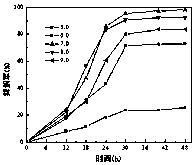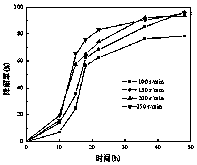A Strain of Ortho-Xylene Degrading Bacteria and Its Application
A technology of o-xylene and degrading bacteria, applied in the direction of bacteria, biological water/sewage treatment, biochemical equipment and methods, etc., can solve the problems of low degradation efficiency of o-xylene, achieve fast degradation speed, high tolerance concentration, good removal effect
- Summary
- Abstract
- Description
- Claims
- Application Information
AI Technical Summary
Problems solved by technology
Method used
Image
Examples
Embodiment 1
[0017] Embodiment 1: Pseudomonas ( Pseudomonas sp . ) Separation and identification of OX5 and its degradation performance of p-xylene
[0018] 1. Isolation and purification of strains
[0019] (1) Source of bacteria
[0020] The source of bacteria was taken from the long-term polluted soil in the sewage treatment plant of Wuhan Pingmei Wuhan Iron and Steel United Coking Co., Ltd., which was black in color. A total of 3 soil samples were collected at different locations.
[0021] (2) Isolation and purification of strains
[0022] Add the collected soil samples to distilled water and shake for 24 hours, after static centrifugation, take 5 ml supernatant and inoculate them in LB medium (peptone 1wt%, sodium chloride 1wt%, yeast extract 0.5wt%), and place at 30°C , 150 r / min constant temperature shaker enrichment culture for 24 h. Take 2 mL of the enriched bacterial solution, centrifuge, discard the supernatant, connect the bacterial cells to the inorganic salt medium conta...
Embodiment 2
[0033] Embodiment 2: environmental condition is to Pseudomonas ( Pseudomonas sp . ) Effect of OX5 degradability
[0034] 1. The influence of culture temperature
[0035] When the concentration of o-xylene is 1000mg / L, the pH is 7.0, the rotation speed of the shaker is 150 r / min, and the inoculum size is 2 vol%, the effect of temperature on the degradation of o-xylene is as follows: figure 2 Shown: In the range of 25-40 ℃, the strain OX5 has a good degradation effect on o-xylene, indicating that the bacteria has a wide adaptability to temperature. When the temperature was between 25 and 35°C, the degradation rate of the substrate increased as the temperature increased; but when the temperature reached 40°C, the degradation rate of the substrate by strain OX5 was lower than that at 35°C Rate. showed that Pseudomonas ( Pseudomonas sp . ) The optimum temperature of OX5 is 35℃.
[0036] 2. The influence of the initial pH value
[0037] When the concentration of o-xylene...
Embodiment 3
[0042] Embodiment 3: Pseudomonas ( Pseudomonas sp . ) OX5 Degradation of benzene series in coking wastewater
[0043] The bacterial suspension of strain OX5 was added to the diluted coking wastewater (COD=604mg / L) with an inoculation amount of 2vol%, and a certain concentration of benzene, toluene, o-xylene, m-xylene and p-xylene were added respectively , cultivated on a shaker at 35°C and 150r / min, measured the concentration of each benzene series remaining in the culture medium after 48 hours, and calculated the degradation rate of the corresponding benzene series as shown in Table 1: strain OX5 can decompose The three xylenes in the wastewater were completely degraded, and the degradation rates of p-benzene and toluene also reached more than 95%, indicating that the strain OX5 can better adapt to the environment in the coking wastewater, and can reduce the benzene series in the wastewater. Good degradation.
[0044] Table 1 Degradation effect of benzene series in coking...
PUM
| Property | Measurement | Unit |
|---|---|---|
| tolerance concentration | aaaaa | aaaaa |
| tolerance concentration | aaaaa | aaaaa |
Abstract
Description
Claims
Application Information
 Login to View More
Login to View More - R&D
- Intellectual Property
- Life Sciences
- Materials
- Tech Scout
- Unparalleled Data Quality
- Higher Quality Content
- 60% Fewer Hallucinations
Browse by: Latest US Patents, China's latest patents, Technical Efficacy Thesaurus, Application Domain, Technology Topic, Popular Technical Reports.
© 2025 PatSnap. All rights reserved.Legal|Privacy policy|Modern Slavery Act Transparency Statement|Sitemap|About US| Contact US: help@patsnap.com



